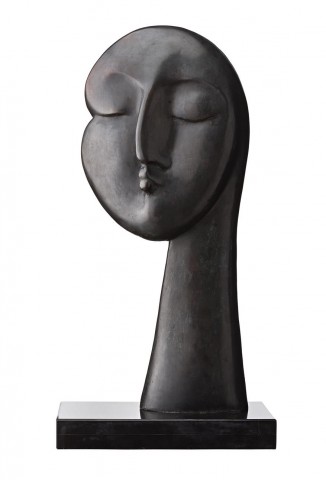MAKIKO, 1980
JOEL ELENBERG
bronze with black Belgian marble base
76.0 cm height including base
signed at base: Joel Elenberg
Private collection, Sydney, acquired directly from the artist
Undoubtedly one of the most remarkable aspects of Joel Elenberg’s artistic evolution is that he only embraced the medium of sculpture four years before his untimely death at the age of 32. Disillusioned with the contemporary sculpture scene which he believed ‘had fallen into disrepute with too much welding, fibre-glassing and clay,’1 Elenberg traveled to Italy in 1976 to pursue the ancient tradition of carving marble – gravitating towards the stone for its timelessness and tactility, but also because ‘it was difficult and in Australia it was unexplored’.2 Upon his pilgrimage to Carrara, Tuscany – the home of marble sculpture since Michelangelo’s time – the young Antipodean thus discovered a whole village of carvers, artists and Italian masons who for generations had been cutting, carrying and chiseling blocks for some of the world’s greatest monuments. As he gleaned their skills and techniques, Elenberg developed such empathy with these local artisans that he subsequently chose them to complete his final sculptures.
Certainly, that marble was ‘difficult’ or posed a considerable challenge for the young sculptor is an understatement. The art of carving was all but lost, the materials were expensive and the very act of chiseling required a strength which Elenberg – in the beginning – did not possess. Perhaps most fundamentally however, whether pursuing the medium of stone or bronze, there was the psychological barrier; modern sculpture in particular had become an intimidating art form. As Elenberg elucidated at the time, ‘People today seem to equate sculpture with a capital S. Most people think of a sculpture as large abstract steel works against big buildings. I wanted to bring it back to a personal level…’3
With its impeccable elegance and daring simplicity, Makiko, 1980 illustrates well how successfully Elenberg reintroduced a sense of intimacy back into contemporary sculpture. Betraying strong stylistic affinities with the streamlined female heads of European modernists such as Matisse, Picasso and Brancusi (who in turn were influenced by the aesthetics of African tribal sculpture), indeed the work offers an exquisitely beautiful example of Elenberg’s achievements. In a similar vein to the work of Brancusi especially, any accumulation of detail is here radically rejected to create a pure and resonant form of timeless, classical proportion. Moreover, that the bronze has been polished to sensuous perfection creates an underlying conflict between medium and form that not only echoes the work of his artistic predecessor, but perhaps reflects Elenberg’s own, self-confessed dual personality – the soft and the lyrical with the tough and intellectual.
Revealing Elenberg’s enduring fascination with ancient votive sculpture, the complex tactile qualities of bronze and more universally, the ‘majesty of man’, thus Makiko encapsulates superbly the artist’s late oeuvre which was so widely acclaimed at the time of its inaugural exhibition that one critic was prompted to remark, ‘…Elenberg has the whole Sydney art world eating out of his hand!’.4 Without question, it is Elenberg at his finest – dignified, serene and always mysterious.
1. Brett Whiteley cited in McGrath, S., ‘Truth – in marble’, The Weekend Australian Magazine, 20 – 21 February 1982, p. 8
2. Elenberg cited in Joel Elenberg: Stone Carving: 1977-78, Robin Gibson Gallery, Sydney, October 1978, unpaginated
3. Elenberg cited in McGrath, S., ‘Marble star’, The Weekend Australian, 14 – 15 October 1978, p. 6
4. ibid.
VERONICA ANGELATOS
